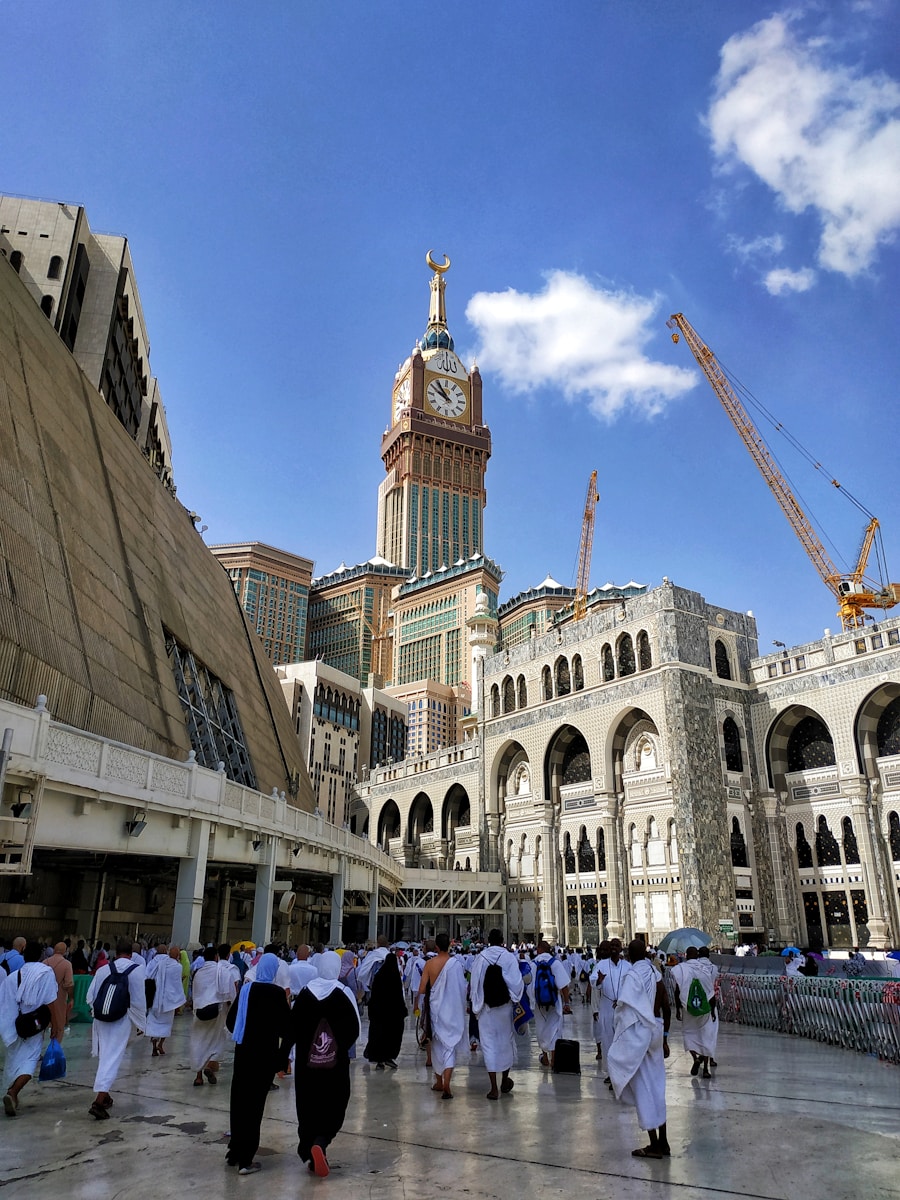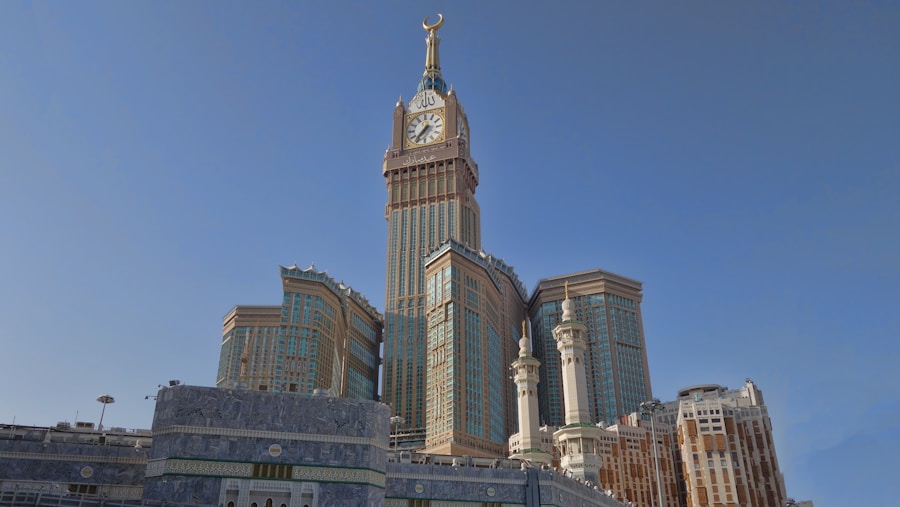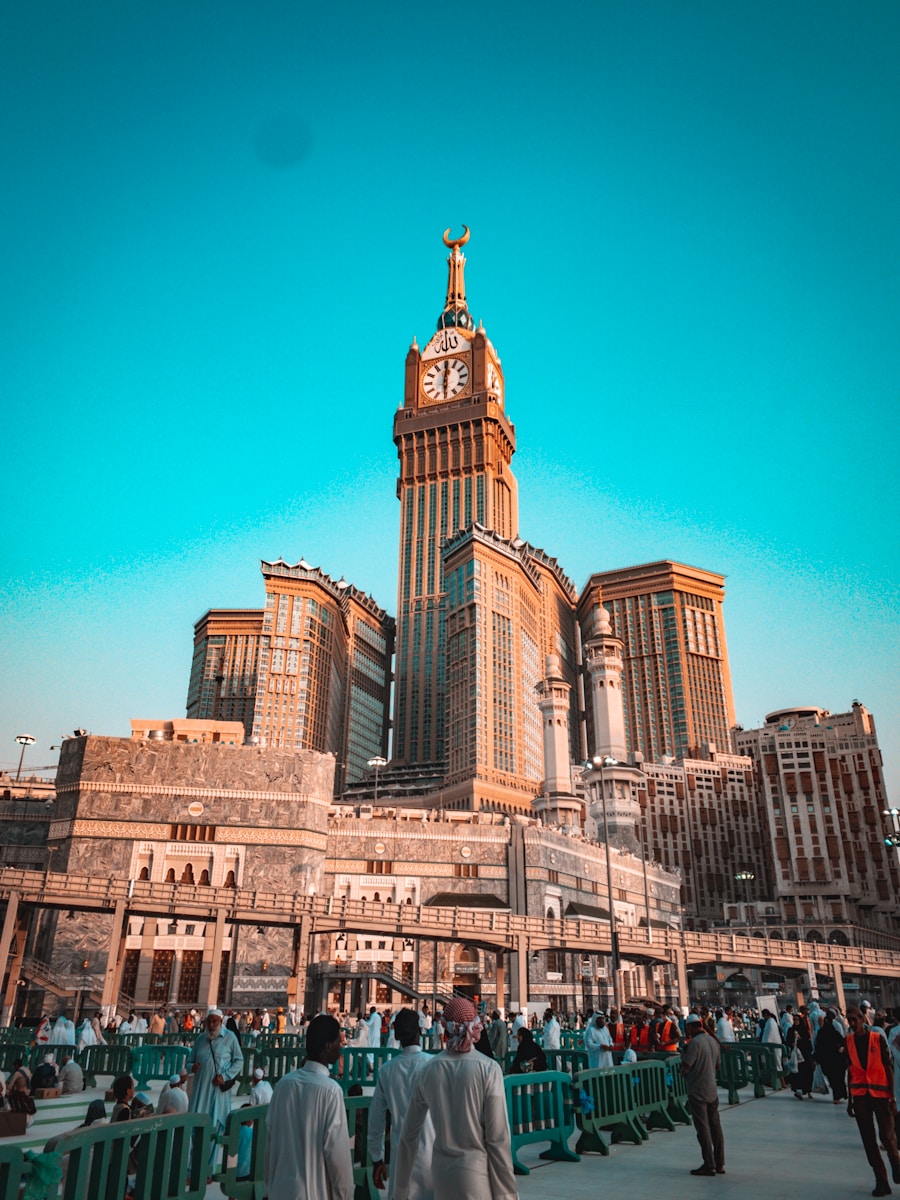Tawaf and Sa’i are two fundamental rituals that hold immense significance in the Islamic pilgrimage of Hajj and the lesser pilgrimage of Umrah. Tawaf involves circumambulating the Kaaba, the sacred structure located in the heart of the Masjid al-Haram in Mecca, while Sa’i consists of walking between the hills of Safa and Marwah. Both rituals are deeply rooted in Islamic tradition and are rich in historical and spiritual meaning.
They serve as acts of devotion, symbolizing the unity of believers in their worship of Allah and their submission to His will. The act of Tawaf is not merely a physical journey around the Kaaba; it is a profound expression of faith and obedience. Pilgrims perform Tawaf by circling the Kaaba seven times in a counterclockwise direction, starting from the Black Stone, which is embedded in one corner of the Kaaba.
This act symbolizes the believer’s love for Allah and their desire to be close to Him. The Kaaba itself is considered the “House of Allah,” and circling it represents a spiritual connection to the divine. Similarly, Sa’i, which involves walking back and forth between Safa and Marwah seven times, commemorates the desperate search for water by Hagar, the wife of Prophet Ibrahim (Abraham), for her son Isma’il (Ishmael).
This ritual embodies themes of perseverance, faith, and reliance on Allah’s mercy.
Key Takeaways
- Tawaf and Sa’i are essential rituals in Hajj and Umrah, symbolizing the unity of Muslims and the journey of Hagar in search of water for her son.
- Before beginning Tawaf and Sa’i, it is important to be in a state of ritual purity, wear appropriate clothing, and mentally prepare for the spiritual experience.
- Tawaf around the Kaaba involves circling the sacred structure seven times in a counterclockwise direction, while reciting prayers and supplications.
- Sa’i involves walking seven times between the hills of Safa and Marwah, commemorating Hagar’s search for water and the mercy of Allah.
- To make the most of the Tawaf and Sa’i experience, it is important to stay focused, maintain humility, and seek forgiveness and guidance from Allah.
Preparing for Tawaf and Sa’i: What to know before you begin
Understanding the Rituals’ Significance
Comprehending the importance of these rituals can elevate the experience, allowing them to approach these acts with reverence and intention. Familiarizing themselves with the specific prayers that can be recited during Tawaf and Sa’i can enrich the experience and provide an opportunity for personal reflection and connection with Allah.
Physical Preparation is Key
Pilgrims should ensure they are in good health, as both Tawaf and Sa’i can be physically demanding, especially given the large crowds that gather during Hajj season. Staying hydrated, wearing comfortable clothing, and choosing appropriate footwear can significantly impact one’s ability to perform these rituals effectively.
Planning for a Smooth Experience
It is advisable to plan the timing of Tawaf and Sa’i to avoid peak hours when the crowds are at their largest. Early mornings or late evenings can provide a more serene environment for worship.
The step-by-step process of performing Tawaf around the Kaaba

Performing Tawaf is a structured process that begins with entering the Masjid al-Haram with humility and respect. Upon entering, pilgrims should make their way towards the Kaaba, ideally approaching it with a sense of awe and reverence. The first step is to stand before the Kaaba, raise both hands in supplication, and recite the intention (niyyah) for performing Tawaf.
This intention signifies that the pilgrim is about to engage in an act of worship solely for Allah’s sake. Once ready, pilgrims begin their circumambulation by touching or pointing towards the Black Stone (Hajr al-Aswad) if possible. The first circuit starts from this point, moving counterclockwise around the Kaaba.
As they walk, pilgrims recite prayers or engage in personal supplications, reflecting on their intentions and desires. Each circuit around the Kaaba consists of four corners: the Black Stone, the corner facing Iraq, the corner facing Syria, and the corner facing Yemen. After completing seven circuits, pilgrims conclude their Tawaf at the Black Stone once again.
The significance of Sa’i: Walking between Safa and Marwah
Sa’i is a ritual that holds profound historical significance as it commemorates Hagar’s search for water for her son Isma’il in the barren desert. This act of desperation and faith is a powerful reminder of human resilience in times of hardship. The hills of Safa and Marwah are not merely geographical landmarks; they symbolize hope, perseverance, and trust in Allah’s provision.
Pilgrims walk between these two hills seven times, reflecting on Hagar’s unwavering faith as she sought sustenance for her child. The journey between Safa and Marwah is not just a physical act; it is an opportunity for spiritual reflection. As pilgrims ascend Safa, they often pause to pray or make supplications, seeking guidance or expressing gratitude.
The descent towards Marwah allows for further reflection on one’s life journey, aspirations, and challenges. This ritual encapsulates the essence of faith—trusting in Allah’s mercy while actively seeking solutions to life’s difficulties.
Tips for making the most of your Tawaf and Sa’i experience
To enhance the experience of Tawaf and Sa’i, pilgrims can adopt several practical tips that promote mindfulness and spiritual engagement. First and foremost, maintaining a sincere intention (niyyah) is crucial. Pilgrims should remind themselves that these rituals are acts of worship meant to draw them closer to Allah.
Engaging in personal supplications during Tawaf allows individuals to express their hopes, fears, and gratitude directly to their Creator. Additionally, it is beneficial to remain patient and composed amidst the crowds. The atmosphere during Hajj can be overwhelming due to the sheer number of pilgrims present.
Practicing deep breathing techniques can help maintain calmness while navigating through busy areas. Furthermore, taking breaks when needed can prevent exhaustion during these physically demanding rituals. Finding moments of solitude amidst the crowd can also provide opportunities for personal reflection.
Common mistakes to avoid during Tawaf and Sa’i

While performing Tawaf and Sa’i is a deeply spiritual experience, there are common pitfalls that pilgrims should be aware of to ensure they fulfill these rituals correctly. One frequent mistake is neglecting to maintain proper etiquette while circumambulating the Kaaba. Pilgrims should avoid pushing or shoving others in an attempt to get closer to the Black Stone or navigate through crowded areas.
Respecting fellow pilgrims fosters an atmosphere of unity and peace.
Pilgrims should also be cautious not to rush through these acts; taking time to reflect on their significance can lead to a more meaningful experience.
Lastly, some may overlook the importance of physical preparation—neglecting hydration or wearing uncomfortable shoes can detract from one’s ability to perform these rituals effectively.
The spiritual and physical benefits of Tawaf and Sa’i
The spiritual benefits derived from performing Tawaf and Sa’i are profound and multifaceted. Engaging in these rituals fosters a deep sense of connection with Allah, allowing pilgrims to express their devotion through physical acts of worship. The repetitive nature of circling the Kaaba and walking between Safa and Marwah serves as a meditative practice that encourages mindfulness and reflection on one’s relationship with God.
Physically, both Tawaf and Sa’i offer health benefits as well. The act of walking several kilometers during these rituals promotes cardiovascular health while also enhancing stamina and endurance. The physical exertion involved can lead to increased energy levels post-pilgrimage as well as improved overall well-being.
Moreover, participating in these rituals within a community setting fosters a sense of belonging among pilgrims from diverse backgrounds, reinforcing shared values and beliefs.
Reflecting on the lessons learned from performing Tawaf and Sa’i
The experience of performing Tawaf and Sa’i often leads to profound personal insights that extend beyond the pilgrimage itself. Many pilgrims report feelings of renewed purpose and clarity after engaging in these rituals. The act of circling the Kaaba serves as a reminder of life’s cyclical nature—how one continually returns to their faith amidst life’s challenges.
Furthermore, walking between Safa and Marwah instills lessons about perseverance in adversity. Just as Hagar demonstrated unwavering faith while searching for water for her son, pilgrims are reminded that challenges can be overcome through trust in Allah’s mercy. These experiences encourage individuals to carry forward their reflections into daily life—fostering resilience, gratitude, and a deeper commitment to their faith long after leaving Mecca.
In conclusion, Tawaf and Sa’i are not merely rituals performed during Hajj or Umrah; they encapsulate essential lessons about faith, perseverance, community, and devotion that resonate deeply within every believer’s journey toward spiritual fulfillment.
If you are interested in learning more about travel and exploring new destinations, you may want to check out the article The Best Kept Secrets About Travel. This article provides valuable insights and tips for making the most out of your travel experiences. Whether you are a seasoned traveler or just starting out, this article is sure to inspire you to embark on new adventures and create lasting memories.
FAQs
What is Tawaf and Sa’i?
Tawaf is the act of circumambulating the Kaaba, the most sacred site in Islam, during the pilgrimage of Hajj or Umrah. Sa’i is the act of walking back and forth between the hills of Safa and Marwah, also performed during the pilgrimage.
What is the significance of Tawaf and Sa’i?
Tawaf and Sa’i are important rituals in Islam, symbolizing the unity of the Muslim community and the act of following in the footsteps of Hagar, the wife of Prophet Ibrahim, as she searched for water for her son Isma’il.
How is Tawaf performed?
Tawaf is performed by walking around the Kaaba seven times in a counterclockwise direction, beginning at the Black Stone corner. Pilgrims recite prayers and supplications as they perform Tawaf.
How is Sa’i performed?
Sa’i is performed by walking back and forth seven times between the hills of Safa and Marwah, following the path that Hagar took in her search for water. Pilgrims also recite prayers and supplications during Sa’i.
Are there any specific rules or etiquettes to follow during Tawaf and Sa’i?
During Tawaf and Sa’i, pilgrims are required to maintain a state of ritual purity, dress modestly, and show respect for the sacredness of the Kaaba and the hills of Safa and Marwah. Men are also required to perform Tawaf with their right shoulder uncovered.



0 Comment